 indicates that the locomotive is equipped with a DCC sound decoder. indicates that the locomotive is equipped with a DCC sound decoder.
Fleischmann 4230
DB BR212 Diesel Locomotive
The V100 or Class 212 diesel locomotive was commissioned by the Munich Bundesbahn Central Administration for light passenger and freight service on branch lines. 364 units were built from 1958 to 1963, with a top speed of 100 km/hr. The Class 212 locomotives were retired from DB service in 2001 though some still are in use by private operators today.
Fleischmann 74230 
DB BR212 Diesel Locomotive [outfitted for DCC Sound with factory-installed ESU LokSound decoder]
This model is the same as the one above, only it is factory-equipped with a sound decoder. 
Roco 4230
DB BR212 Diesel Locomotive
This model is a 2014 rendering of the V100 by Roco. 
Fleischmann 4231
DB BR212 Diesel Locomotive
The V100 or Class 212 was also painted Ozeanblau (ocean blue) and ivory. The Ozeanblau livery was introduced in 1973.

Roco 73381 
DB BR280 Diesel Locomotive [outfitted for DCC Sound with factory-installed Zimo decoder]
The V80-- later renamed Class 280-- was the first newly designed diesel locomotive by the Deutsche Bundesbahn. 10 units were built in 1951-52 which laid the foundation for all further locomotive design of this type. The unusual characteristic of this locomotive was that the driver's cockpit, which was designed for bidirectional travel in one location and Central Administration for light passenger and freight service on branch lines. 10 units were built from 1958 to 1963, with a top speed of 100 km/hr. The Class 212 locomotives were retired from DB service in 2001 though some still are in use by private operators today.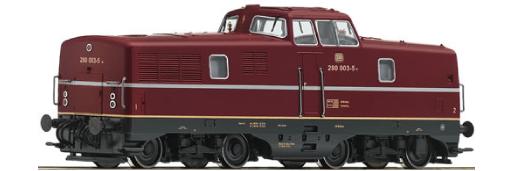
Fleischmann 4225
DB V60 Diesel Locomotive
The Class V60 diesel locomotive was conceived in 1951 as a shunting locomotive. 942 units were manufactured between 1955 and 1963, making this locomotive ubiquitous throughout Germany. Its top speed is 60 km/hr. and most units are still in service by the Deutsche Bahn today.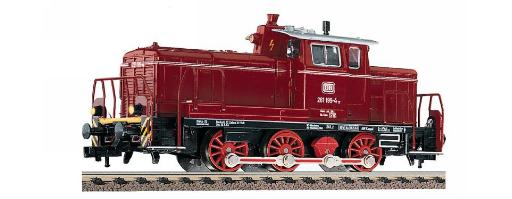
Piko 52402 
DB BR216 Diesel Locomotive [outfitted for DCC Sound with factory-installed Piko Smartdecoder]
The transition from steam to diesel and electric on the German Federal Railroads required a single-engine large diesel locomotive for medium duty service. Beginning in 1960, ten prototypes emerged, of which nine differed significantly from the production models. Starting in 1964, Henschel, KHD, Krauss-Maffei, Krupp, and MaK began production of 214 locomotives, whose MTU engines produced 1400 kW (1877hp). With a top speed of 120 km/h (75 mph), the locomotives were ideal for use with Eilzug (fast trains that stopped at every station) trains and passenger trains. At the same time, their high tractive effort made them suitable for freight service. As the original 216s only had steam heaters, they were displaced from Eilzug service in the 1990s by the Class 218. It was also cheaper to operate railcars where available. The last BR 216s were retired by DB in 2004. 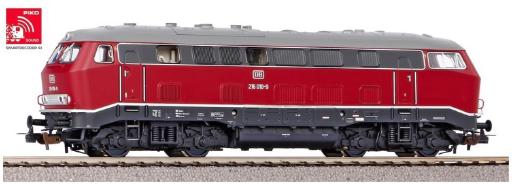
Fleischmann 4235
DB BR218 Diesel Locomotive
The Class 218 diesel locomotive is a powerful diesel electric locomotive developed for mixed use. Its signature characteristic was the whining sound of its diesel turbine generators which powered electric motors which powered the locomotive as opposed to diesel engines. 411 units were built in total from 1968 to 1979 and many units are still in service by the Deutsche Bahn on DB routes today. With power ranging from 2500 to 2800 hp and a top speed of 140 km/h, plus the ability to work in multiple unit consists with related classes 215, 216, 217 and 218 as well as other classes, an electric heating system, and a low speed gear for heavier freight trains, these versatile locomotives became the main source of motive power in West Germany on both passenger and freight trains outside electrified sections.
The turn of the second millennium saw a change from locomotive hauled trains to increasing use of 'diesel railcars' (or DMUs, diesel multiple units). This led to a reduction in the demand for these locomotives on passenger services, and many units fell out of use. Yet in 2000 these locomotives were still in use on mainline long-distance train and as of January 2008 there were approximately 220 of these iconic locomotives still in service. 
Fleischmann 493871 
DB BR218 Diesel Locomotive [outfitted for DCC Sound with factory-installed decoder]
This Class 218 diesel locomotive is in TEE (Trans Europ Express) livery. This version is actually from the WestFrankenBahn (DB-Regio regional rail line), and this locomotive from Fleischmann has DCC sound as well as a track cleaning mechanism.
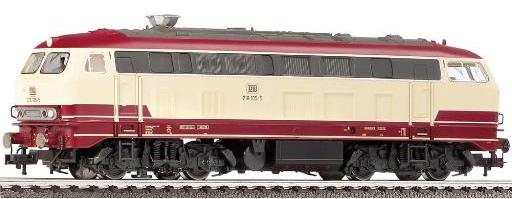
Roco 62846
DB V220 Diesel Locomotive [outfitted for DCC with ESU LokPilot decoder]
The V200 or Class 221 diesel locomotive was designed for heavy passenger and freight service with a top speed of 140 km/hr. 50 units were built from 1962 to 1965. This Roco model is the Class 221 which was retired from Deutsche Bundesbahn service in 1984 though many units are still run by private railroad operators.
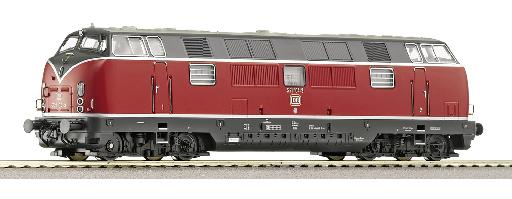
Piko 59706 
DB V220 Diesel Locomotive [outfitted for DCC Sound with Zimo Sound decoder]
This lovely model from Piko is the class 220 featuring the original silhouette with the more sloped front. The later model (Roco 62846, above) added more equipment and required the nose to be more flat to provide more space .

Roco 63078 
DB VT 98/VS 98 Diesel Railbus [outfitted for DCC Sound with factory-installed Sound decoder]
The VT 98 or VS 98 diesel railbus unit was designed for light passenger service on branch lines with a top speed of 90 km/hr. The so-called "Uerdinger Schienenbus" (Railbus of Uerding, built in the Uerding rolling stock factory) was considered the savior of the branch line. In the 1950s, steam operations were no longer economically feasible on Germany's branch lines and the DB was faced with a quandary about what to do. The Uerdinger Schienenbus was the answer. These vehicles were diesel-powered, twin-axle railbuses of light construction. Their diesel motors were built into the chassis underneath the vehicle. They were employed in passenger train duties on branch lines where steam or diesel train operations were less profitable. 1,492 power units were built from 1950 to 1971. Tthe total number of units, including trailer and driving cars, was 3,306. The last unit was retired in 1983 though a number of units continue to be run by private operators and railroad history clubs.

Roco 63099 
DB VT 11.5 Diesel Trainset [outfitted for DCC with factory-installed decoder]
The trainsets of Class VT 11.5 (often simply called TEE) were diesel multiple units built by Deutsche Bundesbahn in 1957 and used for Trans Europ Express (TEE) services. They carried first-class seating only. When the UIC numbering scheme became effective on January 1, 1968, the power heads of the trainsets were renamed to Class 601 while the middle cars became Class 901. They were used for TEE service from 1957 until 1972 and thereafter on German InterCity services.


Source: Wikipedia.

|














